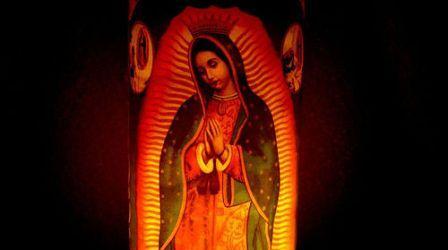by Ariana Garcia
Winter holiday celebrations are particularly important in our culture because they not only bring our families together but they are chock full of traditions that remind us of our roots. One of these particularly Latina traditions is the feast day of Our Lady of Guadalupe-December 12th. This representation of Mary has managed to transcend the generational and international barriers and continues as a popular icon but what is it about “la morenita” that has captivated our community in such a manner?
 I had never really stopped to think about or question the role la Virgen de Guadalupe played in my family. My grandmother prayed rosaries to her, my parents took a trip to the basilica in Mexico City to thank her for our good fortune, but to me this devotion was commonplace. As an immigrant Mexican family speaking to her was as natural as my grandma’s weekly enchiladas. Not until an Irish teacher at my mostly Anglo catholic school asked me to play the role in our annual play did I actually learn her story.
I had never really stopped to think about or question the role la Virgen de Guadalupe played in my family. My grandmother prayed rosaries to her, my parents took a trip to the basilica in Mexico City to thank her for our good fortune, but to me this devotion was commonplace. As an immigrant Mexican family speaking to her was as natural as my grandma’s weekly enchiladas. Not until an Irish teacher at my mostly Anglo catholic school asked me to play the role in our annual play did I actually learn her story.
Shortly after the Spaniards conquered Mexico city, la Virgensita appeared to Juan Diego – a poor Aztec convert. The account of the apparition says a lovely lady with both Spanish and Aztec features called to him as he passed Tepeyac hill. In his native Nahuatl, she assured Juan Diego that she was Mary the mother of God and that she had chosen him to deliver her request of a chapel to the bishop of Mexico City. After several attempts at communicating this request the bishop instructed Juan Diego to bring back a sign from his divine lady to prove she was indeed the Virgin Mary. Mary provided this sign by arranging roses in Juan Diego’s tilma that revealed the now globally recognized image imprinted on the cactus fibers. She also informed Juan Diego that this apparition should be named Coatlallope, which the Spaniards interpreted as Guadalupe. This sign was enough to convince the pope and a chapel was erected shortly after. (A more detailed and moving account can be found here.)
This apparition lives on almost five centuries later for several reasons. The first being the fact that she appeared to an Aztec and spoke Natuatl – rather than a Spaniard and speaking Spanish – helping to revive the hope of these conquered people. Her request was simple: “I desire a church in this place where your people may experience my compassion. All those who sincerely ask my help in their work and in their sorrows will know my Mother’s Heart in this place.” The community that felt their gods had turned their backs on them now had a surrogate mother who would listen to their sorrows and give a miracle whenever possible.
Many years have passed since Europeans first set foot on The Americas but La Virgen de Guadalupe has soldiered on because she remains the advocate of the downtrodden in the hearts of our community. Her message of compassion helped great leaders of change – from Mexican revolutionaries to Cesar Chavez and the United Farm Workers – rally their followers behind their cause. Moreover, she has evolved into a Latin pop culture icon who reminds us that even when times get hard we have the support of our family and community behind us.
While I am the first to admit I am neither a devout nor often practicing Catholic, I still find solace in knowing I can ask for a little extra help from a compassionate being. If nothing else, the festivities surrounding December 12th are my favorites because they are a wonderful representation of our mestizo heritage.
Ariana Garcia is currently a professional in the online advertising industry. She enjoys writing most about topics that touch on our Latin heritage. Her passions are languages, classic literature, and learning something new every day. She holds a BS in Communication from Saint Mary’s College of California and hopes to pursue an MBA in the near future.
